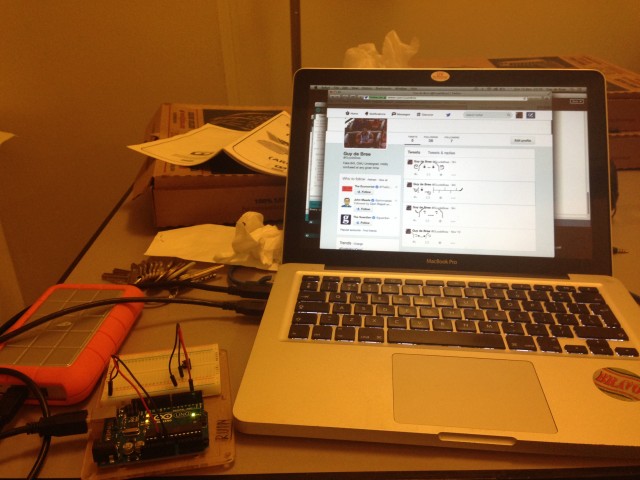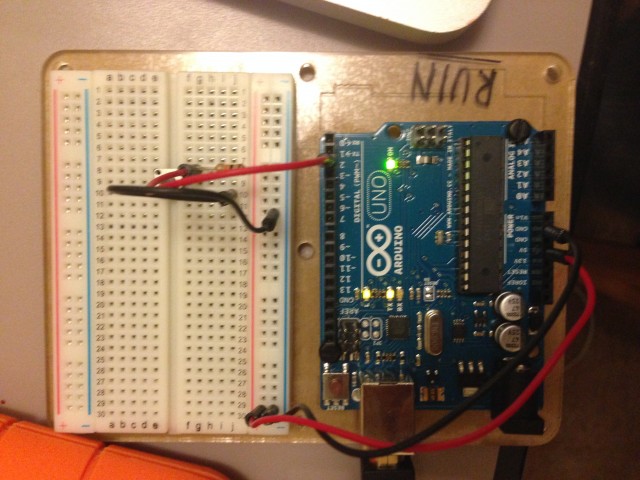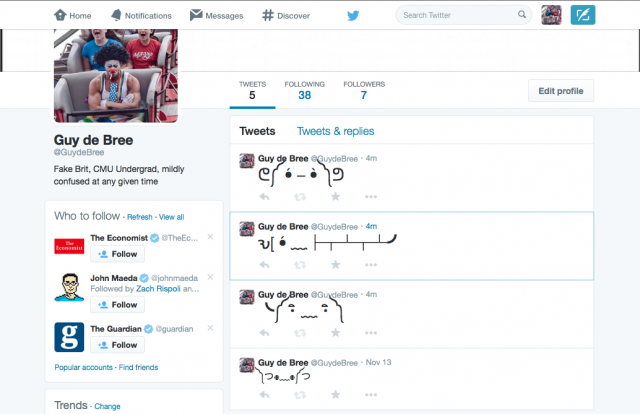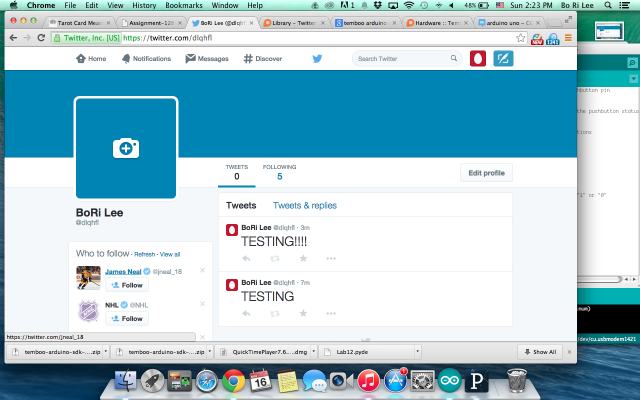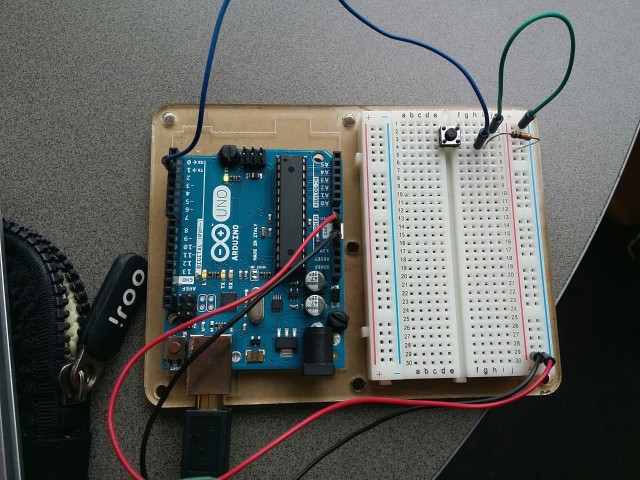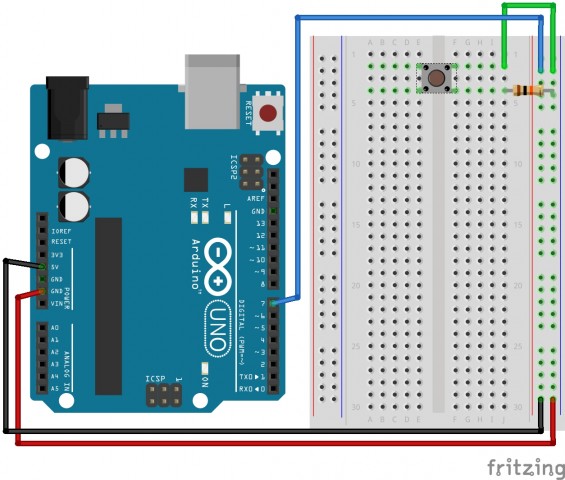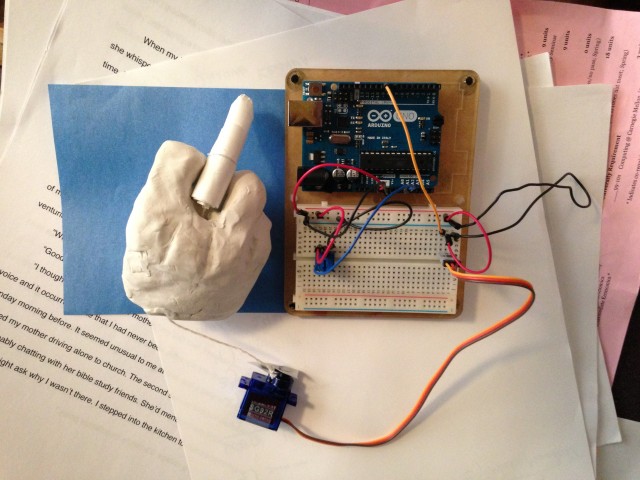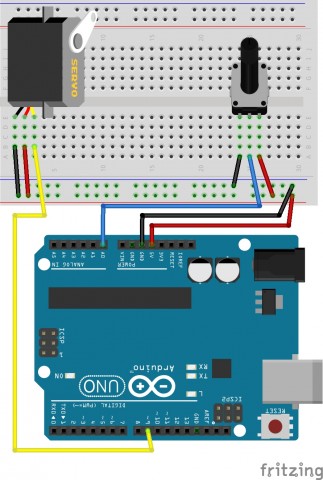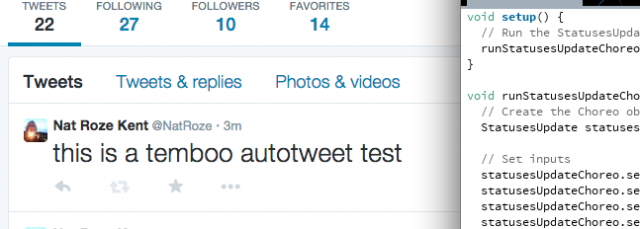Time Capsule Post : Physically Manifesting Facebook Comments
At first, I managed to use the Temboo Facebook choreo to post a test message:
Temboo provides much more Facebook functionality than that, so I wove together a couple more choreos to create the Time Capsule Post. This would consist of an Arduino which, when a button is pushed, would automatically post a status on Facebook. After 12 hours, this status would be automatically deleted, but not before all comments made on the post were downloaded onto the Arduino. As a result, the comments would no longer exist anywhere other than within the memory of the Arduino chip (and probably backed up deep in some Facebook server). Here was my attempted post :
Even though it was posted to my timeline and set to be visible to everyone, no account other than my own was able to view the post. I therefore posted some filler comments myself, and ran the autodelete/comment parsing code, returning this result:
While I never actually constructed the simple pushbutton circuit necessary to run the code, I did create an Arduino C program which would both send and receive data serially to/from my Processing sketch:
Processing:
import com.temboo.core.*;
import com.temboo.Library.Facebook.Deleting.*;
import com.temboo.Library.Facebook.Reading.*;
import com.temboo.Library.Facebook.Publishing.*;
import processing.serial.*;
Serial myPort;
String statid;
String[] results;
int startTime;
boolean posted = false;
int ValueIn;
int ValueOut;
TembooSession session = new TembooSession("hex", "facebooklikekeepingupwith", "4v2AjLyKERbZ8Ate9uuDXYGLINaujfjr");
void setup() {
String portName = Serial.list()[0];
myPort = new Serial(this, portName, 9600);
}
void collectInput()
{
while(myPort.available () > 0 && posted == false)
{
char aChar = (char) myPort.read();
if (aChar == 'o')
{
posted = true
statid = runPostChoreo();
startTime = hour();
}
}
}
void draw()
{
collectInput();
if (posted && (hour() == (startTime + 12) % 24 || keyPressed))
{
results = runCommentsChoreo();
myPort.write(results);
println(results);
runDeleteStatusChoreo();
}
}
String[] runCommentsChoreo() {
Comments commentsChoreo = new Comments(session);
commentsChoreo.setCredential("FacebookAccount");
commentsChoreo.setObjectID(statid);
CommentsResultSet commentsResults = commentsChoreo.run();
println(commentsResults.getResponse());
println(commentsResults.getHasNext());
println(commentsResults.getHasPrevious());
return parseComments(commentsResults.getResponse());
}
String runPostChoreo() {
Post postChoreo = new Post(session);
postChoreo.setCredential("FacebookAccount");
postChoreo.setMessage("This is a Time Capsule Post. In 12 hours, this post will be deleted automatically. Any comments on this post will be archived in a digital capsule. This digital capsule will be buried on the Carnegie Mellon campus for the next 50 years, as a part of CMU's ongoing Social Archiving Initiative (SAI). Please comment, and your messages will be stashed away for posterity.");
PostResultSet postResults = postChoreo.run();
println(postResults.getResponse());
return parseResults(postResults.getResponse());
}
void runDeleteStatusChoreo() {
DeleteObject deleteObjectChoreo = new DeleteObject(session);
deleteObjectChoreo.setCredential("FacebookAccount");
deleteObjectChoreo.setObjectID(statid);
DeleteObjectResultSet deleteObjectResults = deleteObjectChoreo.run();
println(deleteObjectResults.getResponse());
}
String parseResults(String results)
{
String digits = "0123456789_";
while(results.indexOf("\"id\":\"") != -1)
{
results = results.substring(results.indexOf("\"id\":\"") + 6);
for(int i = 0; i < results.length(); i++)
{
if (digits.indexOf(results.charAt(i)) == -1)
{
return results.substring(0,i);
}
}
}
return "-1";
}
String[] parseComments(String results)
{
String[] comments = new String[results.split("from").length-1];
if (comments.length == 0)
{
return new String[] {"no comments"};
}
String commenter = "", comment = "";
int index = 0;
while(results.indexOf("\"from\":") != -1)
{
results = results.substring(results.indexOf("\"from\":\"") + 8);
results = results.substring(results.indexOf("\"name\":\"") + 8);
for(int i = 0; i < results.length(); i++)
{
if (results.charAt(i) == '\"')
{
commenter = results.substring(0,i);
println("commenter: " + commenter);
break;
}
}
results = results.substring(results.indexOf("\"message\":\"") + 11);
for(int i = 0; i < results.length(); i++)
{
if (results.charAt(i) == '"')
{
comment = results.substring(0,i);
println("comment: " + comment);
break;
}
}
comments[index] = commenter + ": " + comment;
index++;
}
return comments;
}
Arduino C:
const int button = 2;
String inputString = "";
boolean stringComplete = false;
void setup()
{
Serial.begin(9600);
pinMode(button, INPUT);
}
void loop()
{
int sensorReading = digitalRead(button);
if(sensorReading == HIGH)
{
Serial.println("go");
}
}
void serialEvent()
{
while (Serial.available())
{
char inChar = (char)Serial.read();
inputString += inChar;
}
}




